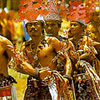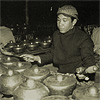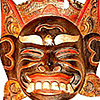 |  |  |
The Folk Dances
Like most of the performing arts of the Orient dance in Indonesia is believed by many scholars to have had its beginning in religious workship. Even today, many dances are considered sacred or can be traced back to their early spiritual associations. Among these are not only the temple dances of Bali, but also such seemingly profane dances, such as the Bedoyo Ketawang of Solo, performed only on such rare occasions that they are in peril of becoming lost for the lack of younger generation dancers able to perform them.
Dance traditions today are as widely diverse as the various ethnic cultures of which they are part. Nurtured to refined perfection in the royal Javanese courts and princely homes the classical dances of Central Java are highly stylized expressions which have probably already attained their basic movements during the height of the Hindu-Javanese culture from the 8th to the 13th century. From the courts, those dances eventually reached the broad strata of the common people who gave them a more spontaneous form of expression.
In the hands of the people, these dances provided a rich source not only for popular dance dramas, but also for social dances which often display clear erotic overtones, such as Tayuban or Ngibing.
The bumbung dance of Bali which incidentally evolved into the beautiful "bumblebee dance" and Tamulilingan, a creation of Bali's late famed maestro of the dance, I Mario.
Other popular folk dances still display strong magic associations, as for instance the "kuda lumping horse dance". Whereas rigid discipline and artistry mark the dance of Java and Bali, those of Sumatra, Maluku and most of the other islands (one exception is the Gending Sriwijaya of South Sumatra) are characterized by their gracefulness and charm, a distinction which is further accentuated by the entirely different, non- gamelan, musical accompaniment.
The old traditions of dance and drama are being preserved in the many dance schools which flourish not only in the courts but also in the modern, government-run or supervised art academies where at the same time the search is continually being conducted for new expressions better adapted to modern times though based on the old traditions.
 10:27 AM
10:27 AM
 admin
admin

 Posted in:
Posted in: 

0 comments:
Post a Comment